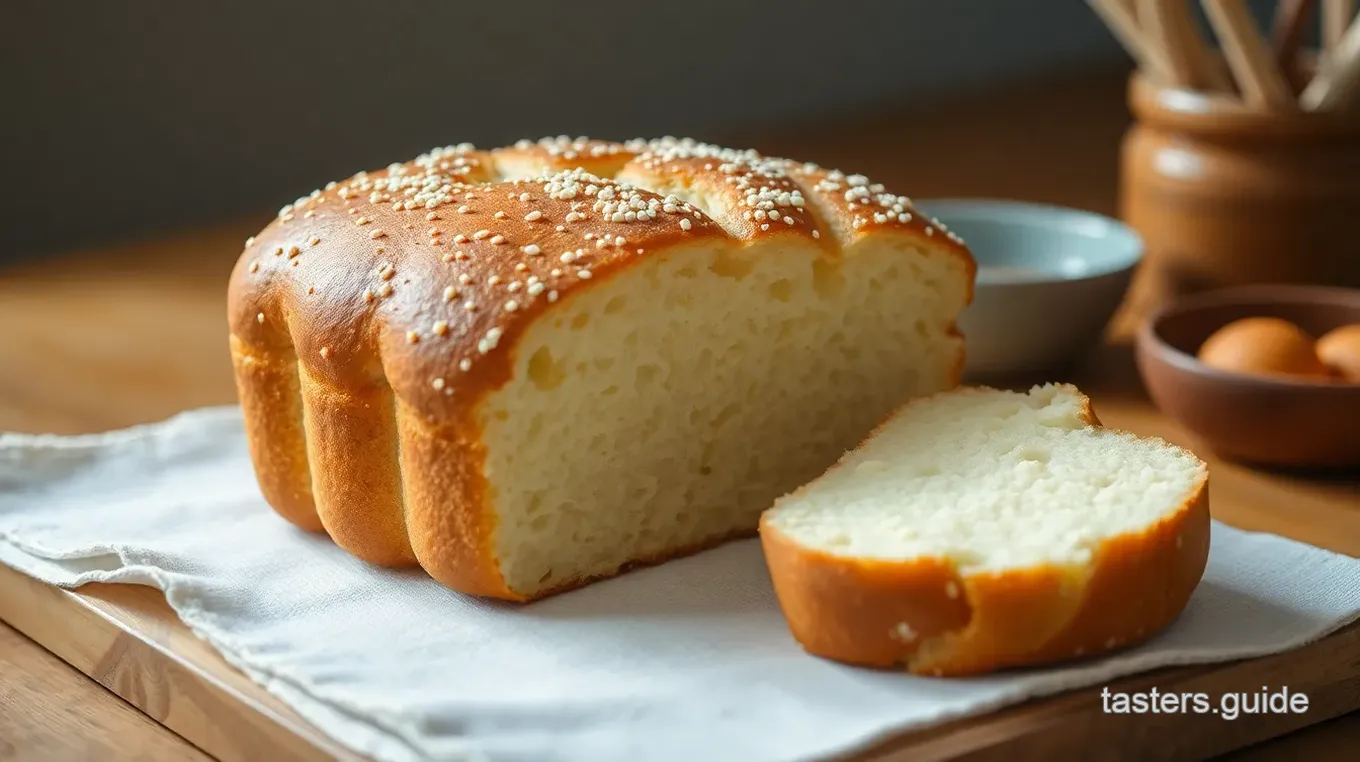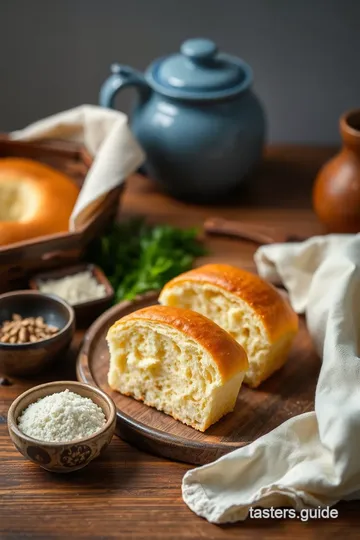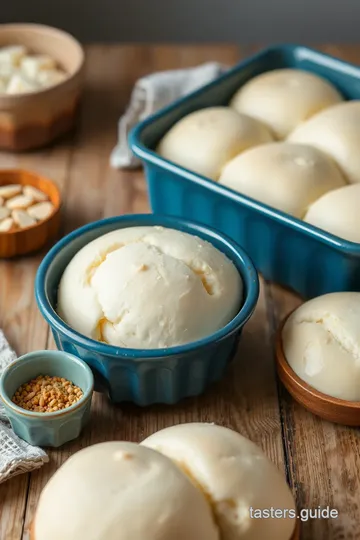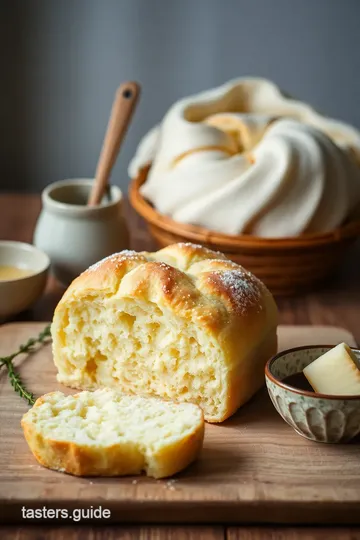Bake Japanese Milk Bread - Fluffy Delight
Ever wondered how to bake Japanese Milk Bread - Fluffy Delight? This fluffy wonder, just like my grandmother made, is perfect for breakfast or toast! Let's dive in!

- Bake Japanese Milk Bread - Fluffy Delight: A Personal Journey
- Essential Ingredients Guide
- Mastering the Art of Professional Cooking
- Pro Tips & Secrets for Baking Success
- Perfect Presentation Ideas
- Storage & Make-Ahead Tips
- Creative Variations
- Complete Nutrition Guide
- Expert FAQ Solutions
- Recipe Card
Bake Japanese Milk Bread - Fluffy Delight: A Personal Journey
Have you ever bitten into a piece of bread and thought, "wow, this is fluffy magic!"? that first taste of japanese milk bread , or shokupan , hit me like a sweet surprise.
I remember trying it one rainy morning at a local café. the bread was so soft, it practically melted in my mouth.
Ever since then, i've been on a quest to bake japanese milk bread - fluffy delight right in my own kitchen.
With its moist, airy texture and hint of sweetness, this bread isn’t just for sandwiches; it’s perfect for breakfast, snacks, or even a midnight treat!
From Japan to Your Kitchen
So, what’s the story behind this soft sensation? originating in japan, shokupan has become a staple in many households. it's more than just soft sandwich bread ; it’s part of japanese culture.
Back in the day, during the meiji era, when western influences poured into japan, bread-making techniques evolved, leading to this unique style that's both versatile and delightful.
Today, it’s a hit everywhere—from fancy brunch spots to cozy kitchens across the globe.
When you step into the baking scene, using the tangzhong method is key. it sounds fancy, but it’s just a cooked flour-water mixture that keeps the dough ultra-soft.
Don’t worry too much about the technique; it’s easier than it sounds. honestly, with a bit of patience, anyone can create this masterpiece!
How Much Time Do You Need?
Now let’s talk practicalities! making your own japanese bread requires a bit of time—about 3 hours total if you include rising time.
You’ll spend approximately 20 minutes prepping, with 30 minutes cooling for the tangzhong. bake it for 30 minutes , and just like that, you'll have a loaf that yields around 12 delicious slices .
What about costs? Well, this isn’t your everyday loaf that drains your wallet. Most ingredients are basic kitchen staples, making it a budget-friendly project!
The Fluffy Benefits
Let’s get into the nitty-gritty of why this bread is such a game-changer. first off, there’s the health aspect . using milk not only makes it taste incredible but also contributes some vitamins and protein.
Plus, it's a fantastic option for brunch or when you're entertaining guests! think about it: that warm, sliced bread spread with butter and jam just brings people together.
What sets this bread apart? its unique fluffiness comes from the cooking with yeast and the tangzhong , which lead to a light and airy loaf that’s perfect for any occasion.
You know those pillow-soft store-bought breads? this homemade version takes them all to school! trust me, when you pull it out of the oven, there’s nothing quite like that moment.
Wrap Up Before We look into into Ingredients
Alright, i’m sure by now you’re itching to fill your kitchen with the aroma of fresh-baked goodness. but before you race to the pantry, let’s get ready to gather those ingredients.
You’ll be amazed at home much joy a simple loaf of japanese milk bread can bring. get ready for your friends and family to be wowed as you pull out that gorgeous, golden loaf that they won't be able to resist.
Stay tuned—next, we’re diving into the exciting world of ingredients that will make this fluffy delight come to life!

Essential Ingredients Guide
When you're diving into the world of baking, understanding your essential ingredients is key to whipping up mouth-watering treats. for instance, whether you're going for that delectable japanese milk bread - fluffy delight or any other bread that dreams are made of, knowing the ins and outs of your components can make all the difference.
Premium Core Components
Let’s start with the basics. Measurements matter. If you're like me and you love both ounces and grams, let's break it down - 3 cups (360g) of bread flour for your dough, and trust me, don’t skimp on quality!
When buying ingredients, look for quality indicators . for flour, check the packaging for high-protein content (that's your bread flour!) and a nice, fine texture.
Storage guidelines are crucial too. keep your flour in a cool, dry place and it should last about six months unopened.
But once you open the bag, aim for three months max for peak freshness.
Talking about freshness tips , always smell and feel when selecting your ingredients. a fresh bag of flour should smell like, well, flour, and not stale or musty.
For that tangy twist, make sure your yeast is alive and kicking. if it bubbles and foams when mixed with warm water and a pinch of sugar, you’re golden!
Signature Seasoning Blend
Now, let’s spice things up! a killer signature seasoning blend can elevate any recipe from eh, to omg! for your japanese bread, the magic lies in a few simple spices and herbs.
Basic salt is a must, but sprinkle in a pinch of nutmeg or even cinnamon if you’re feeling adventurous.
The herb selections can be as flexible as your taste. fresh rosemary or dill can bring unique flair to savory breads, while a bit of vanilla can sweeten the deal for your japanese dessert bread creations.
And don’t sleep on the regional variations ! got some pickled ginger or miso paste? toss that into your mix for an unforgettable twist.
Smart Substitutions
Sometimes, life gets in the way and you just don't have the right ingredients. that's where smart substitutions come in.
If you’re out of bread flour, no worries! just grab that all-purpose flour - your loaf might be a tad less chewy, but hey, it’s still going to be delicious.
For those who are gluten-free or sticking to a diet, dairy-free bread options are totally doable. swap out the whole milk for almond milk or use oil instead of butter.
Your loaf might transform into something new and equally scrumptious.
Sometimes, you don't have the time for baking from scratch. keep a note of those emergency replacements too. have frozen bread dough? perfect for last-minute sandwiches! or if you're missing eggs, some mashed banana can work wonders in a pinch.
Kitchen Equipment Essentials
You can’t bake without the right tools! here’s a rundown of must-have kitchen equipment . first off, a solid mixing bowl is essential.
I recommend at least one big enough to let your dough rise without a mess. a stand mixer can be a lifesaver too, especially if you’re kneading by hand sounds like a workout you’re not ready for.
Don’t forget about your loaf pan . a classic 9x5-inch pan is perfect for most bread recipes. and let’s face it, if you’re about to become a daring baker , a sturdy rolling pin might quickly become your best friend.
Easy preparation tips ? Always keep a damp kitchen towel handy to cover your dough while it rises. It helps create a warm and cozy environment, which your yeast will love.
Next Up: Getting Baking!
There you have it! a quick rundown of everything from your essential baking ingredients to the nifty kitchen tools that will have you on your way to bake japanese milk bread - fluffy delight in no time.
It’s all about those small details that make your loaf light, airy, and absolutely perfect. so, roll up those sleeves and get ready to create something that will knock everyone’s socks off! next up, i’ll take you through how to create that perfect loaf step by step .
Get excited!
Mastering the Art of Professional Cooking
Cooking is like a dance, and with the right moves, you can create a masterpiece! let’s dive into a professional cooking method that will up your culinary game.
We’ll break it down into preparation steps, a step-by-step process, expert techniques, and strategies to ensure you're turning out dishes that not only taste amazing but look stunning too.
Essential Preparation Steps
First things first: mise en place . it’s a fancy french term, but it simply means having everything in its place.
Before you start cooking, gather all your ingredients and tools. it’s a game-changer, trust me!
Next up, let’s chat about time management . set a timer—seriously! cooking can get chaotic, and knowing when to flip the pancake or pull the bread out of the oven makes all the difference.
If you’re trying out this delightful bake japanese milk bread - fluffy delight , keep track of rising times and baking durations.
Organization is key. keep your workspace tidy. cleaning as you go feels like magic! finally, let’s not forget safety considerations .
Always use oven mitts when handling hot trays. a burned finger is no joke, friends!
Step-by-Step Process
Alright, let’s get the nitty-gritty going.
-
Prepare the tangzhong : mix 3 tbsp (27g) bread flour with ½ cup (120ml) water in a saucepan. cook it over medium heat, stirring until it’s thickened for about 1- 2 minutes .
Cool that down.
-
Mix the dough : in a bowl, combine 3 cups (360g) bread flour , 2 tbsp (25g) sugar , 2 tsp (7g) instant yeast , and 1 tsp (5g) salt .
In a separate bowl, whisk together warmed milk and one egg. combine all (including the tangzhong)—this is the magic moment!
-
Knead it : time to get those hands dirty! knead until smooth, about 10 minutes . if you’re using a mixer, it’ll take about 5 minutes .
That’s how you get that lovely and soft sandwich bread texture.
-
First Rise : Let it sit in a greased bowl, covered. It needs about 1 hour to double. Patience is definitely a virtue here!
-
Shape It : Punch down, divide the dough into three, roll them, and shape into a loaf. Pop that in a greased loaf pan.
-
Second Rise : Cover with a damp cloth again for another 45 minutes , or until it fills the pan.
-
Bake : Preheat your oven to 350° F ( 175° C) . Bake for 25- 30 minutes —that’s the sweet spot where it turns golden brown and sounds hollow when tapped.
-
Cool and Serve : Let it cool on a rack. Now you can slice it up!
Expert Techniques
Those pro cooking tips take your skills to another level. When you're mixing, don’t be shy about using your hands. It really helps you feel the dough's texture.
Quality checkpoints are crucial. Check your dough; it should be elastic and smooth. If it’s sticky even after kneading, add a sprinkle of flour—don’t go overboard, though!
Also, if your bread isn’t rising, your yeast might be expired. test your yeast with warm water and sugar beforehand.
And always aim for an internal temperature of 200° f ( 93° c) before calling your loaf done!
Success Strategies
Every cook has their off days, so here are some common mistakes to avoid . Don’t rush the rising times; they’re essential for that light and airy bread.
Don’t skimp on quality ingredients. bread flour vs all-purpose flour makes a difference! bread flour gives that chewy structure, while all-purpose might not yield the same fluffiness.
Use proper baking equipment too; a good loaf pan makes all the difference.
Lastly, if you're tight on time, consider make-ahead options . you can freeze the dough before the second rise, then just let it thaw and rise when you’re ready.
Easy bread recipes for the win!
Additional Information...
Baking japanese milk bread is an art that reflects the best of soft, tender goodness we crave. if you’ve never tried making shokupan before, this recipe is going to knock your socks off.
Perfect for sandwiches or just slathered with butter and jam, it’s a slice of heaven on a plate. happy baking, and may your homemade bread bring joy to your table!

Pro Tips & Secrets for Baking Success
Oh my gosh, can we talk about how delicious it is to bake japanese milk bread - fluffy delight ? seriously, it’s like a little cloud in your mouth! but let's chat about ways to make your bread-making process easier and more fun.
First off, if you’re new to the tangzhong method , don't sweat it! it sounds fancy, but it's just mixing flour and water and heating it until it thickens.
This simple technique keeps your bread fluffy and moist. when adding your tangzhong to the dough , make sure it’s cooled to room temp or you risk shocking the yeast.
Yikes!
Time-saving tip : you can prep the tangzhong the night before. just pop it in the fridge and bring it back to room temp when you're ready to bake.
Prepping early can make you feel like a pro!
For flavor enhancements, think beyond the basics. a splash of vanilla in your dough can elevate the sweetness to new heights.
Plus, mixing in a little cinnamon or nutmeg gives a subtle warmth that feels like a big, cozy hug — perfect for those chilly mornings.
Perfect Presentation Ideas
So you've baked your soft sandwich bread , and it looks gorgeous. But let's be real, presentation matters! If you're looking to impress, there are a few tricks up your sleeve.
Start with plating techniques — a simple white plate can make your fluffy bread loaf pop! You can even slice it thickly and fan the pieces out for a visual appeal that screams “look at me!”
For garnishes, consider fresh herbs or edible flowers — they bring a nice splash of color. and don't forget about the color combinations ! a bright raspberry jam next to your white slices creates a stunning contrast.
It’s all about making your food look as good as it tastes!
Also, sprinkle a little flour over your finished loaf before slicing. It gives a rustic charm while displaying that beautiful crust.
Storage & Make-Ahead Tips
Now, nobody wants dry bread unless it’s for stuffing, am i right? to keep your japanese milk bread fresh, make sure it cools completely before wrapping it tightly in plastic wrap.
Store it at room temperature for a few days.
If you want it to last longer, freeze it! just slice it first, pop the slices in a freezer bag, and you’re golden.
When you're ready for a toast of warm bread, just pull out the slices and toast them straight from the freezer.
They’ll taste just as luscious!
Creative Variations
Want to shake things up? there are tons of ways to get creative with this shokupan recipe ! you can substitute the whole milk for almond or oat milk if you’re looking for dairy-free bread options .
Feeling adventurous? toss in some chocolate chips for a sweet twist or go savory with cheese poppers inside. and of course, seasonal variations are a must! consider adding pumpkin puree in the fall for a festive bread loaf.
Complete Nutrition Guide
Now, let’s keep it real. making homemade bread isn't just about the love you put into it but also about what you're putting in it.
The calories and nutritional info per slice of this milk bread sit around 130, which isn’t bad considering the flavor you’re getting.
Fiber content is decent, too, and believe me, that little bit of sugar will satisfy your sweet tooth without sending you into a sugar coma.
Plus, the health benefits of homemade bread include knowing exactly what’s floating around in your dough — no mysterious preservatives here!
Expert FAQ Solutions
Okay, real talk: let’s answer some common burning questions.
Why didn’t my bread rise? most likely, your yeast is not active enough. a quick tip is to quick-test the yeast by mixing it with warm water and sugar first.
If it bubbles, you’re good to go.
What about shape? if you’re looking for a more artisan appearance, try rolling your dough differently. you can braid it or roll it into a circular shape.
I’ve tried both, and let me tell you: it’s all about how you want to serve it!
You’re ready to tackle this baking adventure. honestly, once you get the swing of making this light and airy bread, you’ll be impressing friends and family with your japanese dessert bread in no time.
So get out there and bake japanese milk bread - fluffy delight ! you got this! happy baking!

Bake Japanese Milk Bread - Fluffy Delight Card

⚖️ Ingredients:
- 3 tbsp (27g) bread flour
- ½ cup (120ml) water
- 3 cups (360g) bread flour
- 2 tbsp (25g) granulated sugar
- 2 tsp (7g) instant yeast
- 1 tsp (5g) salt
- ¾ cup (180ml) whole milk, warmed
- 1 large egg
- 4 tbsp (56g) unsalted butter, room temperature
🥄 Instructions:
- Step 1: Prepare the Tangzhong: In a small saucepan, whisk together the bread flour and water. Cook over medium heat, stirring until thickened (about 1-2 minutes). Remove from heat and let cool to room temperature.
- Step 2: Mix the Dough: In a large bowl or stand mixer, combine the bread flour, sugar, yeast, and salt. In a separate bowl, whisk together warmed milk and egg; add to the dry ingredients. Add the cooled tangzhong and begin mixing.
- Step 3: Knead the Dough: Add the softened butter and knead until the dough is smooth and elastic (about 10 minutes by hand or 5 minutes with a mixer).
- Step 4: First Rise: Form the dough into a ball, place it in a greased bowl, and cover with plastic wrap. Let it rise in a warm place until doubled in size, about 1 hour.
- Step 5: Shape the Loaf: Punch down the dough and transfer it to a lightly floured surface. Divide into three equal pieces, roll each into a rectangle, and then shape into rolls. Place the rolls seam side down in the greased loaf pan.
- Step 6: Second Rise: Cover the pan with a damp cloth and let it rise again for about 45 minutes, or until it fills the pan.
- Step 7: Bake: Preheat the oven to 350°F (175°C). Bake the bread for 25-30 minutes until golden brown and sounding hollow when tapped on the bottom.
- Step 8: Cool and Serve: Transfer the bread to a wire rack to cool before slicing.
Previous Recipe: How to Make Hot Chocolate - Rich, Creamy & Decadent: A Cozy Recipe
Next Recipe: How to Make the Best No-Bake Cheesecake with Creamy Filling
